Choosing the best organizational structure for your company, division, or team is a lot like picking out a new car.
At the most basic level, you’re always looking for something road-worthy — something that can take you (and your passengers) from point A to point B without a hitch.
But beyond that, there are a lot of options to consider. Automatic or manual? Four-wheel drive or two? Built-in GPS? Leather interior? Flux capacitor? (Only if you’re going back in time, of course.)
In the world of organizational structures, the options you have to choose from include things like chain of command (long or short?), span of control (wide or narrow?), and centralization (centralized or decentralized decision-making?), just to name a few.
Organizational structures can use functions, markets, products, geographies, or processes as their guide, and cater to businesses of specific sizes and industries.
What’s the point of an organizational structure? As a business leader, do you even need one? As your company gets bigger, an organizational structure can also be helpful for new employees as they learn who manages what processes at your company.
Then, if you need to pivot or shift your leadership, you can visualize how the workflows would work by adjusting your organizational structure diagrams.
To put it simply, an organizational structure is like a map that simply explains how your company works and how its roles are organized.
Four Basic Elements of Organizational Structure
An organizational structure typically has four essential elements; you can add more building blocks or components, depending on your business needs.
No matter what, ensure you include the following basic elements:
Chain of Command
Your chain of command is how tasks are delegated and work is approved. An org structure allows you to define how many “rungs of the ladder” a particular department or business line should have. In other words, who tells whom to do what? And how are issues, requests, and proposals communicated up and down that ladder?
Departmentation
Departmentation is one of the most important elements of your organizational structure. It clusters your teams by similar roles and responsibilities and allows you to understand how each department connects to one another.
Span of Control
Your span of control can represent two things: who falls under a manager’s, well, management … and which tasks fall under a department’s responsibility. Having a defined span of control not only avoids double-work from your different teams, but helps you identify gaps in your structure.
Centralization
Centralization describes where decisions are ultimately made. Once you’ve established your chain of command, you’ll need to consider which people and departments have a say in each decision. A business can lean toward centralized, where final decisions are made by just one or two entities; or decentralized, where final decisions are made within the team or department in charge of carrying out that decision.
You might not need an org structure right away, but the more products you develop and people you hire, the harder it’ll be to lead your company without this crucial diagram.
Below, we’ll explore how you can combine those components to form different types of organizational structures. We’ll also highlight the benefits and drawbacks of different structure types so you can evaluate which is the best option for your company, division, or team. Let’s dive in.
Mechanistic vs. Organic Organizational Structures
Organizational structures fall on a spectrum, with “mechanistic” at one end and
“organic” at the other.
Take a look at the diagram below. As you’ll probably be able to tell, the mechanistic structure represents the traditional, top-down approach to organizational structure, whereas the organic structure represents a more collaborative, flexible approach.
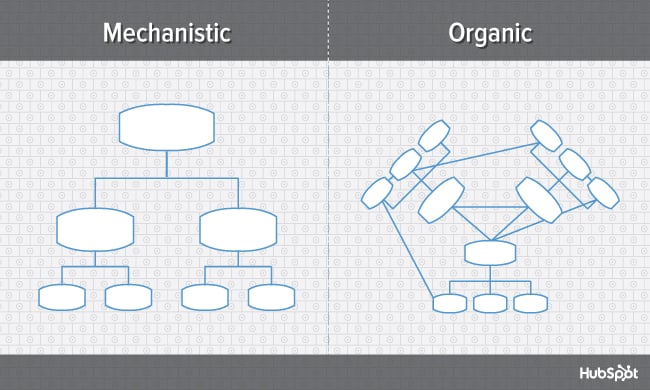
Here’s a breakdown of both ends of the structural spectrum, their advantages and disadvantages, and which types of businesses are suited for them.
Mechanistic Structure
Mechanistic structures, also called bureaucratic structures, are known for having narrow spans of control, as well as high centralization, specialization, and formalization. They’re also quite rigid in what specific departments are designed and permitted to do for the company.
This organizational structure is much more formal than organic structure, using specific standards and practices to govern every decision the business makes. And while this model does hold staff more accountable for their work, it can become a hindrance to the creativity and agility the organization needs to keep up with random changes in its market.
As daunting and inflexible as mechanistic structure sounds, the chain of command, whether long or short, is always clear under this model. As a company grows, it needs to make sure everyone (and every team) knows what’s expected of them. Teams collaborating with other teams as needed might help get a business off the ground in its early stages, but sustaining that growth — with more people and projects to keep track of — will eventually require some policymaking. In other words, keep mechanistic structure in your back pocket … you never know when you’ll need it.
Organic Structure
Organic structures (also known as “flat” structures) are known for their wide spans of control, decentralization, low specialization, and loose departmentalization. What’s that all mean? This model might have multiple teams answering to one person and taking on projects based on their importance and what the team is capable of — rather than what the team is designed to do.
As you can probably tell, this organizational structure is much less formal than mechanistic, and takes a bit of an ad-hoc approach to business needs. This can sometimes make the chain of command, whether long or short, difficult to decipher. And as a result, leaders might give certain projects the green light more quickly but cause confusion in a project’s division of labor.
Nonetheless, the flexibility that an organic structure allows for can be extremely helpful to a business that’s navigating a fast-moving industry, or simply trying to stabilize itself after a rough quarter. It also empowers employees to try new things and develop as professionals, making the organization’s workforce more powerful in the long run. Bottom line? Startups are often perfect for organic structure, since they’re simply trying to gain brand recognition and get their wheels off the ground.
Now, let’s uncover more specific types of organizational structures, most of which fall on the more traditional, mechanistic side of the spectrum.
Depending on the size of a business and its goals, the organizational structure of the team will vary. Each type has its advantages and disadvantages; however, there is a universal benefit to establishing a clear organizational structure. It helps employees understand their role within a company, which enables them to manage expectations and goals.
A business needs to have an organizational structure in place to be successful. There are several types of organizational structures commonly used by companies, nine of which we expand upon below.
1. Functional Organizational Structure
One of the most common types of organizational structures, the functional structure departmentalizes an organization based on common job functions.
An organization with a functional org structure, for instance, would group all of the marketers together in one department, group all of the salespeople together in a separate department, and group all of the customer service people together in a third department.
The functional structure allows for a high degree of specialization for employees, and is easily scalable should the organization grow. Also this structure is mechanistic in nature — which has the potential to inhibit an employee’s growth — putting staff in skill-based departments can still allow them to delve deep into their field and find out what they’re good at.
Disadvantages
- Functional structure has the potential to create barriers between different functions — and it can be inefficient if the organization has a variety of different products or target markets.
- The barriers created between departments can also limit peoples’ knowledge of and communication with other departments, especially those that depend on other departments to succeed.
Advantages
- Functional organization increases efficiency, provides stability, and boosts accountability.
- It also allows departments — with employees who share similar skills and knowledge — to focus on their specialized tasks within their respective fields.
- Because the roles and responsibilities of this organizational structure example rarely change, department employees can consistently work on similar assignments and hone their skills.
The fixed structure of functional organization also operates through management. It provides employees with a chain of command. It guides communication between the team and keeps the team accountable.
2. Product-Based Divisional Structure
A divisional organizational structure is comprised of multiple, smaller functional structures (i.e. each division within a divisional structure can have its own marketing team, its own sales team, and so on). In this case — a product-based divisional structure — each division within the organization is dedicated to a particular product line.
This type of structure is ideal for organizations with multiple products and can help shorten product development cycles. This allows small businesses to go to market with new offerings fast.
Disadvantages
- It can be difficult to scale under a product-based divisional structure.
- The organization could end up with duplicate resources as different divisions strive to develop new offerings.
Advantages
- Companies and their employees can experience the benefits of the product-based divisional structure.
- If one division performs poorly, this does not automatically translate across the organization.
- Because of their separation, divisions may flourish (or fail) concurrently. This system allows companies to mitigate risk.
3. Market-Based Divisional Structure
Another variety of the divisional organizational structure is the market-based structure, wherein the divisions of an organization are based around markets, industries, or customer types.
The market-based structure is ideal for an organization that has products or services that are unique to specific market segments, and is particularly effective if that organization has advanced knowledge of those segments. This organizational structure also keeps the business constantly aware of demand changes among its different audience segments.
Disadvantages
- Too much autonomy within each market-based team can lead to divisions developing systems that are incompatible with one another.
- Divisions might also end up inadvertently duplicating activities that other divisions are already handling.
Advantages
- Because this organizational structure focuses on specific market segments, it provides each division with autonomy.
- The divisions work separately, which allows employees to work independently and enables them to focus on the needs of their particular industry.
4. Geographical Divisional Structure
The geographical organizational structure establishes its divisions based on — you guessed it — geography. More specifically, the divisions of a geographical structure can include territories, regions, or districts.
This type of structure is best-suited to organizations that need to be near sources of supply and/or customers (e.g. for deliveries or for on-site support). It also brings together many forms of business expertise, allowing each geographical division to make decisions from more diverse points of view.
Disadvantages
- It can be easy for decision- making to become decentralized, as geographic divisions (which can be hundreds, if not thousands of miles away from corporate headquarters) often have a great deal of autonomy.
- When you have more than one marketing department — one for each region — you run the risk of creating campaigns that compete with (and weaken) other divisions across your digital channels.
Advantages
- Geographical divisions allow companies the advantage of catering to a specific customer. Based on the differences in language, culture, and customs one would find across the world, companies cannot necessarily expect the same operations to work in different locations.
- Not only does it allow organizations to tailor their approach based on geography, but it allows the division to react quickly and efficiently to any geographical market changes.
5. Process-Based Structure
Process-based organizational structures are designed around the end-to-end flow of different processes, such as “Research & Development,” “Customer Acquisition,” and “Order Fulfillment.” Unlike a strictly functional structure, a process-based structure considers not only the activities employees perform, but also how those different activities interact with one another.
In order to fully understand the diagram below, you need to look at it from left to right: The customer acquisition process can’t start until you have a fully developed product to sell. By the same token, the order fulfillment process can’t start until customers have been acquired and there are product orders to fill.
Process-based organizational structure is ideal for improving the speed and efficiency of a business, and is best-suited for those in rapidly changing industries, as it is easily adaptable.
Disadvantages
- Similar to a few other structures on this list, process-based structure can erect barriers between the different process groups.
- It may lead to problems communicating and handing off work to other teams and employees.
Advantages
- As mentioned, one of the most significant benefits of the process-based structure is that it increases efficiency and speed. If Department B cannot start its processes until Department A finishes, this compels Department A to work promptly and proficiently.
- This organizational model also promotes intradepartmental (within the department) and interdepartmental (across multiple departments) teamwork.
6. Matrix Structure
Unlike the other structures we’ve looked at so far, a matrix organizational structure doesn’t follow the traditional, hierarchical model. Instead, all employees (represented by the green boxes) have dual reporting relationships. Typically, there is a functional reporting line (shown in blue) as well as a product- based reporting line (shown in yellow).
When looking at a matrix structure org chart, solid lines represent strong, direct-reporting relationships, whereas dotted lines indicate that the relationship is secondary, or not as strong. In our example below, it’s clear that functional reporting takes precedence over product-based reporting.
The main appeal of the matrix structure is that it can provide both flexibility and more balanced decision-making (as there are two chains of command instead of just one). Having a single project overseen by more than one business line also creates opportunities for these business lines to share resources and communicate more openly with each other — things they might not otherwise be able to do regularly.
Disadvantages
- The primary pitfall of the matrix organizational structure? Complexity. The more layers of approval employees have to go through, the more confused they can be about who they’re supposed to answer to.
- This confusion can ultimately cause frustration over who has authority over which decisions and products — and who’s responsible for those decisions when things go wrong.
Advantages
- An advantage of a matrix structure is that it promotes collaboration and communication.
- This open line of communication ultimately allows businesses to share resources and allows employees to develop new skills from working with different departments.
7. Circular Structure
While it might appear drastically different from the other organizational structures highlighted in this section, the circular structure still relies on hierarchy, with higher-level employees occupying the inner rings of the circle and lower-level employees occupying the outer rings.
That being said, the leaders or executives in a circular organization aren’t seen as sitting atop the organization, sending directives down the chain of command. Instead, they’re at the center of the organization, spreading their vision outward.
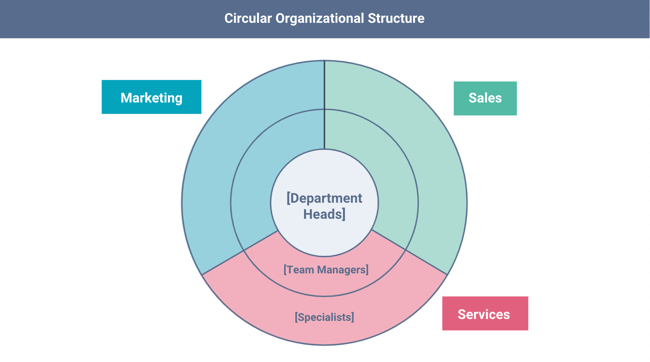
From an ideological perspective, a circular structure is meant to promote communication and the free flow of information between different parts of the organization. Whereas a traditional structure shows different departments or divisions as occupying individual, semi-autonomous branches, the circular structure depicts all divisions as being part of the same whole.
Disadvantages
- From a practical perspective, the circular structure can be confusing, especially for new employees.
- Unlike with a more traditional, top-down structure, a circular structure can make it difficult for employees to figure out who they report to and how they’re meant to fit into the organization.
Advantages
- Most examples of organizational structure have a top-down hierarchy. Alternatively, this type of structure follows an outward flow and contributes to information flowing freely across the business.
- Its benefits include keeping all employees aligned with the processes and goals of the company and encouraging employees to collaborate between departments.
8. Flat Structure
While a more traditional organizational structure might look more like a pyramid — with multiple tiers of supervisors, managers and directors between staff and leadership, the flat structure limits the levels of management so all staff are only a few steps away from leadership. It also might not always take the form or a pyramid, or any shape for that matter. As we mentioned earlier, It’s also a form of the “Organic Structure” we noted above.
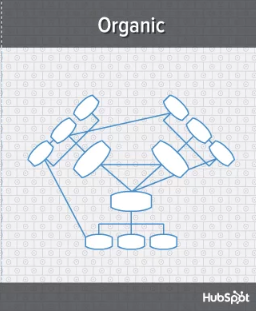 This structure is probably one of the most detailed, It’s also thought that employees can be more productive in an environment where there’s less hierarchy-related pressures. This structure might also make staff feel like the managers they do have are more like equals or team members rather than intimidating superiors.
This structure is probably one of the most detailed, It’s also thought that employees can be more productive in an environment where there’s less hierarchy-related pressures. This structure might also make staff feel like the managers they do have are more like equals or team members rather than intimidating superiors.
Disadvantages
- If there’s a time when teams in a flat organization disagree on something, such as a project, it can be hard to get aligned and back on track without executive decisions from a leader or manager.
- Because of how complicated the structure’s design is, it can be tricky to determine which manager an employee should go to if they need approval or an executive decision for something.
- If you do choose to have a flat organization, you should have a clearly marked tier of management or path that employers can refer to when they run into these scenarios.
Advantages
- The elimination of middle management employees defines the flat structure type. Its advantages are instantaneous. First, it reduces the expenses of the company.
- Second, it allows staff to build direct relationships with upper management.
- Lastly, it shortens the decision-making process.
9. Network Structure
A network structure is often created when one company works with another to share resources — or if your company has multiple locations with different functions and leadership. You might also use this structure to explain your company workflows if much of your staffing or services is outsourced to freelancers or multiple other businesses.
The structure looks nearly the same as the Divisional Structure, shown above. However, instead of offices, it might list outsourced services or satellite locations outside of the office.
If your company doesn’t do everything under one roof, this is a great way to show employees or stakeholders how outsourcing of off-site processes work. For example, if an employee needs help from a web developer for a blogging project and the company’s web developers are outsourced, the could look at this type of chart and know which office or which person to contact outside of their own work location.
Disadvantages
- The shape of the chart can vary based on how many companies or locations you’re working with. If it’s not kept simple and clear, there may be a lot of confusion if multiple offices or freelancers do similar things.
- If you do outsource or have multiple office locations, make sure your org chart clearly states where each specific role and job function lies so someone can easily understand your basic company processes.
Advantages
- The outsourcing nature of the network structure provides companies with the advantages of lower costs, more focus, and increased flexibility.
- Outsourcing allows organizations to save money, as they don’t have to bear the expense of setting up a department for the same purpose.
- It also gives companies the flexibility to change their processes and the ability to focus on their core functions.
Organizational Structure Examples
Organizational structure can both refer to your company’s structure at large, or your individual teams. No matter what, you usually want to have a different structure for each department, due to the distinct needs and functions of each one.
We’ll start with organizational structure examples for both companies and nonprofits, then delve into team-specific charts.
1. Company Organizational Structure Example: Matrix Type

This matrix organizational structure example for an imaginary engineering company starts with the CEO at the helm. However, instead of including a C-suite (such as a chief marketing officer, a chief finance officer, a chief technology officer, and so on), it includes vice presidents who then oversee individual contributors.
Each contributor works cross-collaboratively with members of others teams on a specific customer project. This is a good example to follow if you run a small-to-medium company in a project-based or region-based firm.
2. Nonprofit Organizational Structure Example: Flat Type
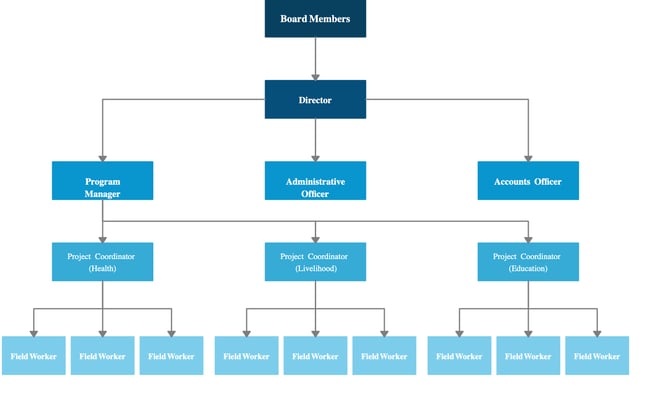
Nonprofits are structured differently than a company, and are usually much smaller and scrappier. In this nonprofit organizational structure example, we see a flat-type of structure, where every employee is only just a few steps away from the director. There are no internal movement opportunities, which works well at most nonprofits. Instead, the focus is on steering the organization to meet its program goals.
Notice that the leader is not the director, but rather the board, who interfaces directly with the director to relay organizational decisions.
3. Marketing Organizational Structure Example: Functional Type

A marketing team’s organizational structure will vary depending on the size of a company. In this example, we see a functional structure type, where the teams are split based on job function. Here, the marketing team is headed by a chief marketing officer (CMO), who overlooks smaller departments divided into six functions: Social media, content, product, SEO, website, and acquisition.
Your marketing team, however, can also adopt a matrix organizational structure if you laterally divide your individual contributors and managers based on region, country, project, or another factor.
4. Sales Organizational Structure Example: Functional Type
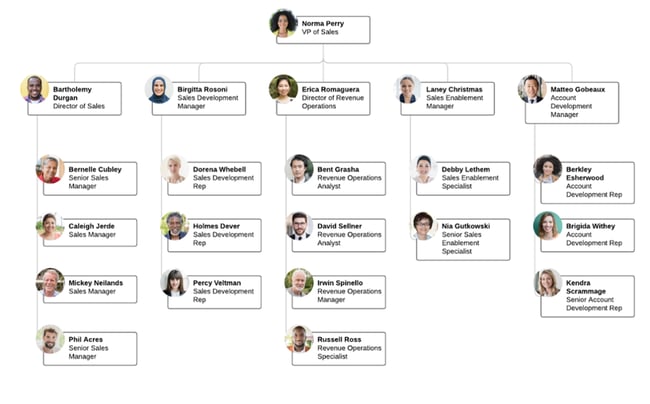
In many sales organizations, organizational structures are deeply hierarchical, where a vice president of sales overlooks a director of sales, and then the director of sales overlooks a team of sales managers, and the sales managers overlook a team of sales representatives, and so on.
In this example of a sales organizational structure, roles are not as hierarchically structured, and instead divided based on function. The VP of sales overlooks a varied team, which includes a director of sales, a sales development manager, a director of revenue operations, a sales enablement manager, and an account enablement manager.
While these are each at different stages of their careers, they are all at the same level and are responsible for a specific function within the team.
5. IT Organizational Structure Example: Functional Type
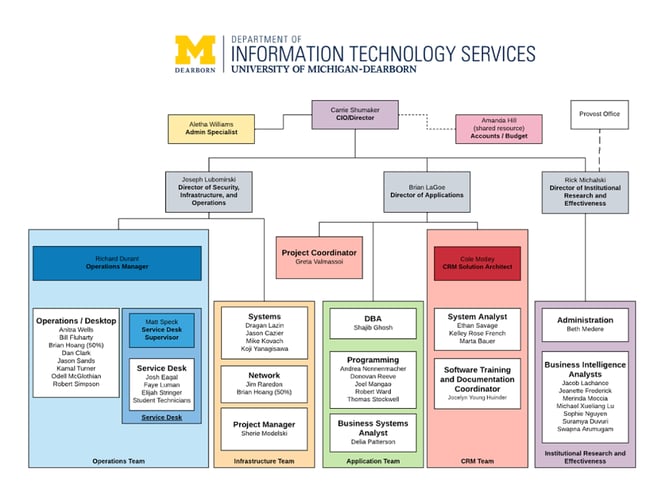
This is another functional org chart example, but this time, it’s for IT. In this example from the University of Michigan, the IT department is divided based on function. Overseen by a Chief Technology Officer, three directors supervise security, infrastructure, and operations; applications; and institutional research and effectiveness.
Within each team is a specialization. For instance, the director of applications oversees both the application team and the CRM team. If you run an IT org, you can take a similar approach, or divide your leadership based on specific processes, such as system maintenance or IT services.
6. Product Organizational Structure Example: Divisional Type
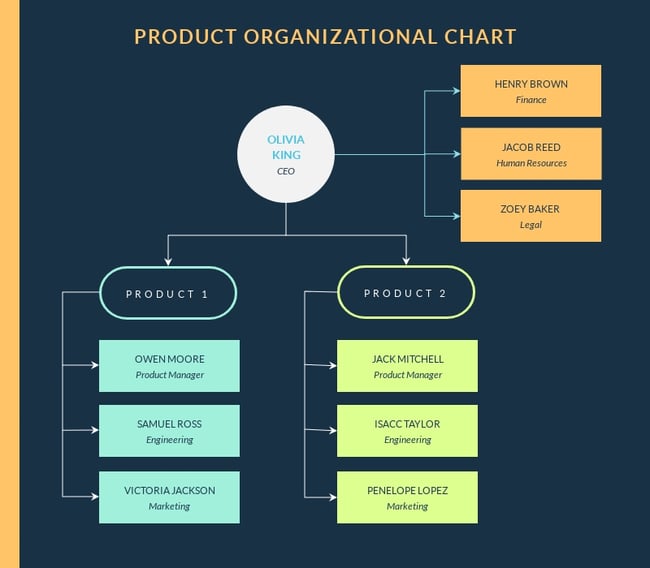
For product organizations, the most common organizational structure is divisional, where teams are divided based on the product they’re working on. Within each product team, there’s typically a product manager, an engineer, a marketer, and even a customer support manager. Depending on how big or small your company is, you may have multiple product managers for one product.
Conversely, if there’s only one product, then the entire company may be a product organization. This time, the organization would be structured based on process, like the example below.

In the above example, the company is divided by processes such as product management, sales and marketing, product development, service and support, and operations. This is a good example to follow if your company is small.
7. HR Organizational Structure Example: Matrix Type
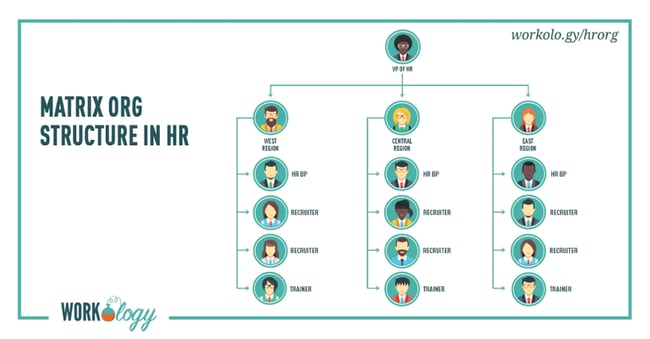
This HR organizational chart is an excellent example of the matrix structure type. Here, the VP of HR oversees three different regions, all of which have an HRBP, two recruiters, and one trainer. Horizontally, the HRBPs, recruiters, and trainers are all aligned.
This is an excellent example to follow if your company is a large enterprise with hiring operations in different regions. It’s especially useful if there are different hiring laws in each region where you operate.
Organizational Structure: Things to Know
What is an organizational structure chart?
An organizational structure chart is a diagram that shows your departments, starting from C-Suite leaders to individual contributors, as well as your company’s order of command and decision-making flow.
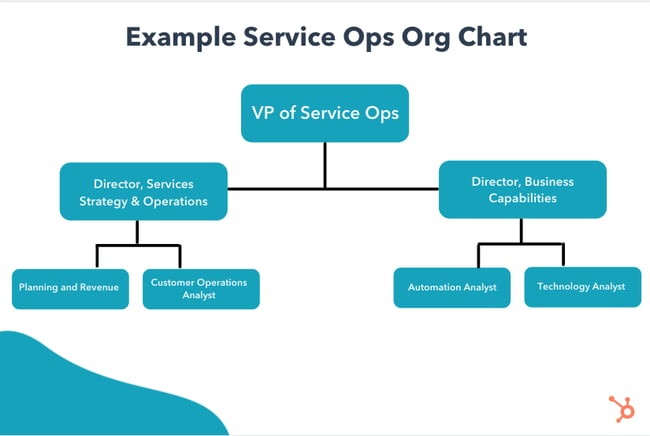
Why is having an organizational structure important?
Imagine a business that has no organizational structure. Instantly, questions arise about the systems and processes. Who makes the decisions? How are employees held accountable? What are the company’s goals? These questions are practically impossible to answer without a functional organizational structure.
Organizational structure is necessary for running a successful business because it improves workflow and efficiency, promotes communication, identifies company needs, and aligns employees with company goals. It directly affects how a business operates daily. When a company establishes a structure that works, the combined efforts of its employees, in conjunction with its systems and processes, allow the company to make better decisions for its future.
What is the best organizational structure?
The best organizational structure varies from business to business and largely depends on your team size, company type, and product offerings. That said, a functional organizational structure (also named “traditional line organizational structure” or “hierarchical structure”) is an excellent place to start if you’re not sure which org structure is right for you.
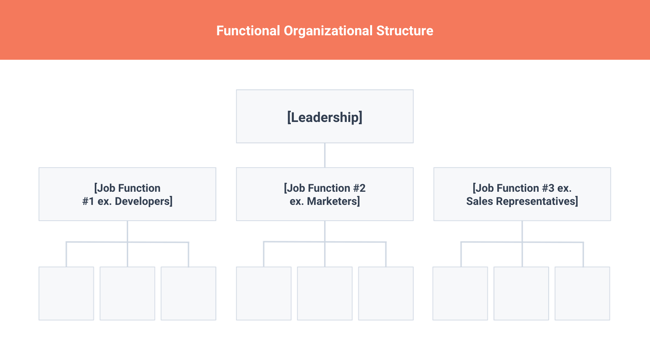
What are the four basic forms of organizational structure?
The four basic forms of organizational structure are functional, divisional, matrix, and flat structures.
Functional organizational structures divide your company teams based on job functions and responsibilities.
Divisional organizational structures groups your teams based on products, markets, or regions, with smaller organizational structures for each division of your business.
Matrix organizational structures divide your company teams in a grid-based fashion, where every team has dual reporting relationships with the C-Suite and another team.
A flat organizational structure keeps hierarchy to a minimum by eliminating middle management and keeping individual contributors as close as possible to leadership.
How do businesses determine organizational structure?
Businesses determine organizational structure by taking stock of their current workforce and teams, then carefully aligning their company strategy, employee feedback, and leadership goals with a specific structure.
Some companies may have naturally fallen into a functional org structure, in which case it’s only a matter of creating an org diagram. Others may be in the process of creating one. Here are the steps to determine an org structure from scratch:
- Audit your organization’s teams and roles. First, it’s essential to understand which teams and roles already exist within your business. If your business is new, create a list of planned teams and hires.
- Draft a company strategy. Your org structure should support your strategy, not detract from it. If your strategy is to launch X new products in the market, then a product-based divisional structure might work well for you.
- Gather feedback from existing employees. Your existing employees are a gold mine of information when creating an organizational structure. Some employees might want to be closer to leadership; others might want advancement opportunities. For the first, a flat structure would fit, and for the second, a functional structure would be best.
- Gather feedback from other leaders. Just as employees’ voices matter, so, too, do leaders’ voices matter. Understand their key goals and the support they need to do their best work at your firm.
- Align your company strategy, employee feedback, and leadership feedback with an org structure. Take a look at organizational structure types and try to align them with the data and observations you’ve collected. Sometimes, the decision will be clear; other times, you’ll need to continue interviewing and gathering data to find the best structure for you.
- Create an org chart. Now that you’ve chosen the right org structure, it’s time to create a visual chart that shows your company’s chain of command, departmentation, span of control, and centralization at a minimum. Share this chart over email and be sure to keep it in an easy place for all employees to access.
Navigating Organizational Structures
Organizational structures are central to a successful team. Employees can move comfortably, confidently, and efficiently when given a clear definition of their role within an organization.
Structure types will vary from business to business, so it’s important to remember that these structures are not one size fits all. Every type may not suit your organization, but chances are, one of them will. Use this post to determine which organizational structure works for you, and then it’s time for the real work to begin.
Editor’s note: This post was originally published in December 2014 and has been updated for comprehensiveness.


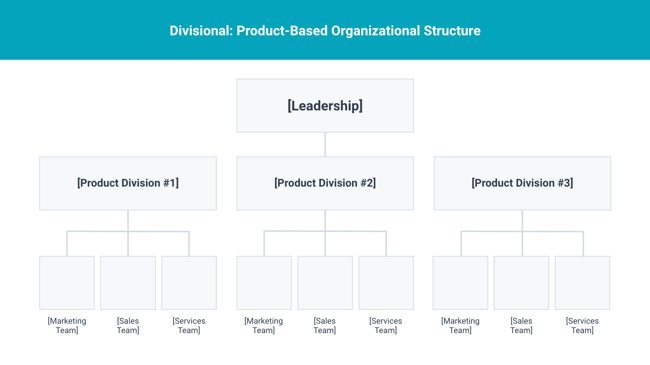
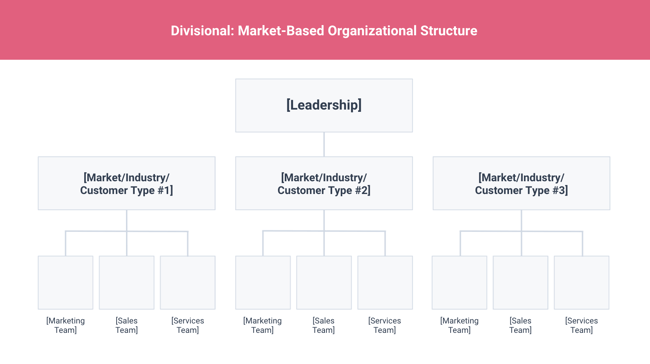
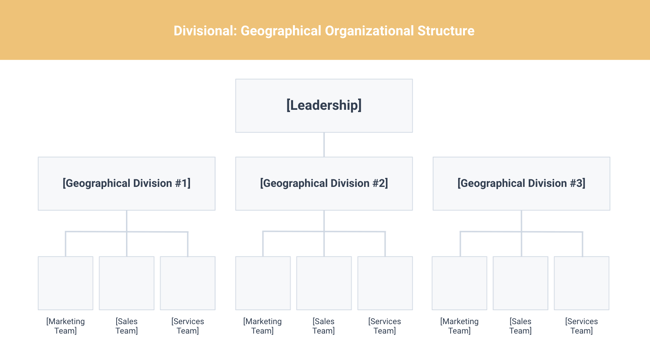
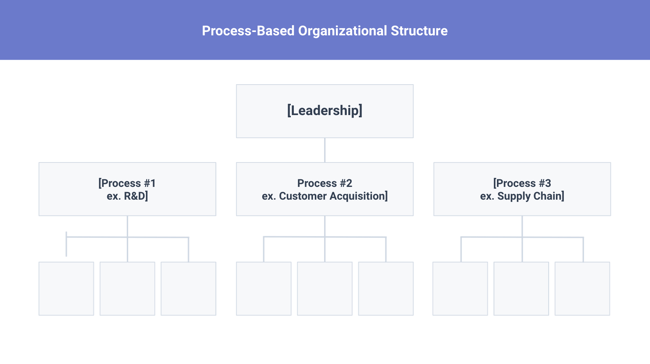
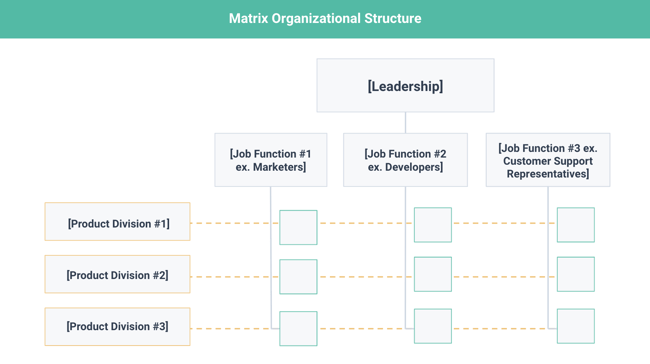 Download the Template
Download the Template
